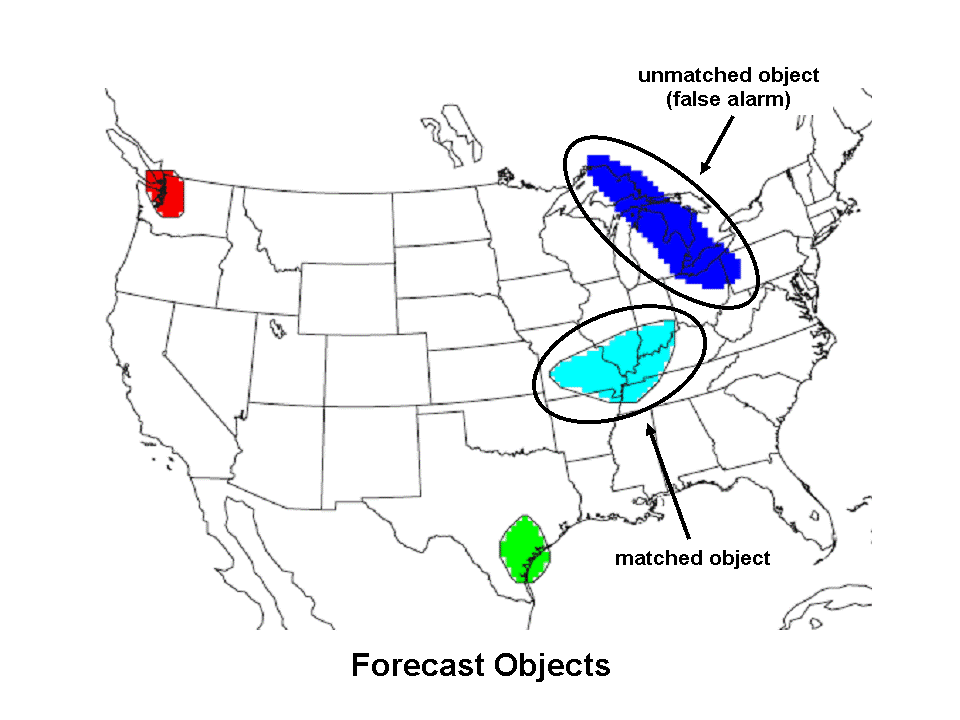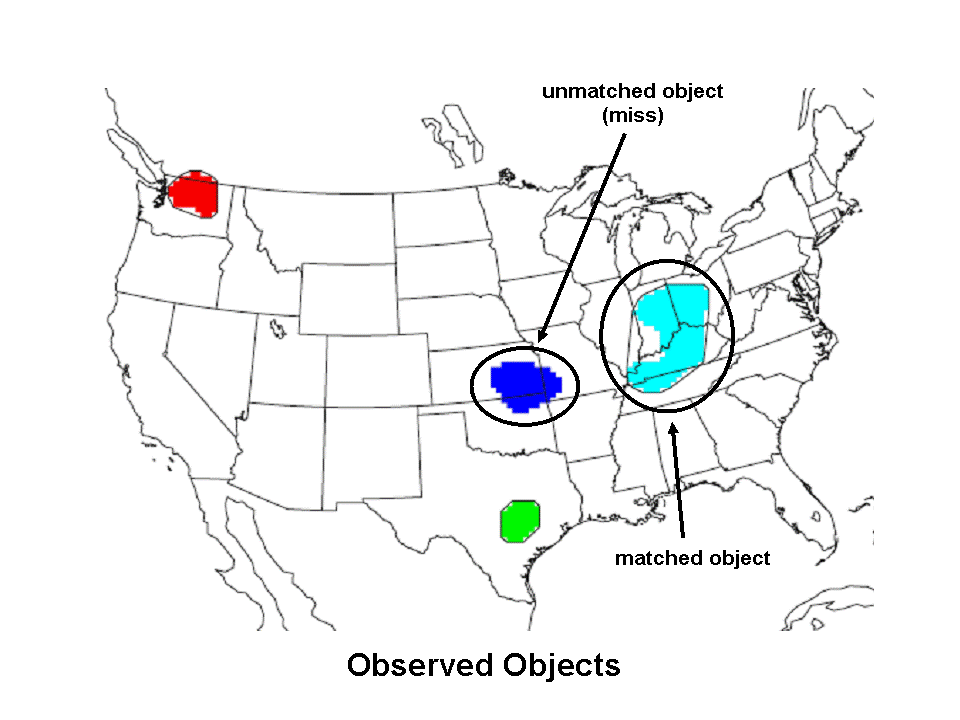24 Hr QPF ending at 12 UTC on:
WPC Forecast (24hr)
|
Observed(MRMS-prelim)
|
24 Hr QPF ending at 12 UTC on:
There are no statistics for observed objects of 0.50 inch on 04/18/2025
Background
The Method for Object-Based Diagnostic Evaluation (MODE) is an object-oriented
verification technique that is part of the
Model Evaluation Tools (MET) verification package developed by the
Developmental Testbed Center (DTC)
. Object-oriented verification methods have been developed in an attempt to better
account for spatial discontinuities between forecast and observed precipitation as well
as provide more specific information about forecast quality than can be obtained from
traditional verification measures (threat score, bias, etc.) alone. These techniques
are considered particularly useful for evaluating high resolution model guidance.
Traditional verification methods often struggle to accurately assess the performance of
high resolution models since even small spatial errors can result in the forecast being
penalized twice (once for missing the observed precipitation and a second time for giving
a false alarm). The goal of the MODE tool is to evaluate forecast quality in a manner
similar to a forecaster completing a subjective forecast evaluation.
How it Works
MODE identifies precipitation objects in both the forecast and observed fields at a
number of different thresholds. It then uses a variety of object characteristics (ex:
distance between objects, size of objects, angle of orientation, etc.) to determine the
degree of similarity between objects in the forecast and observed fields. Objects that
are found to be similar to one another are considered “matched”, while those that are
not similar are considered “unmatched”. Unmatched objects in the forecast
field are equivalent to a false alarm. Unmatched objects in the observed field are
equivalent to a miss. Examples of the graphical verification output produced by MODE
are below. Matched objects are indicated in the same color in both the forecast and
the observed fields. In this case, the red, green, and light blue objects are matched
with one another. Unmatched objects are always displayed in dark blue.
In addition to the graphical output, MODE also provides statistical information for each
matched object. This information includes a parameter called the interest value, which is
an overall measure of similarity between objects in the forecast and observed fields. The
interest value ranges from 0 to 1, with a value of 0.70 required for objects to be considered
matched. In addition to the interest value, MODE also provides information about the displacement
distance, which is defined as the distance between the center of a forecast object and the center
of the corresponding observed object.
MODE at WPC
MODE verification is available for Day 1, Day 2, and Day 3 forecasts of 24 hr precipitation valid
at 1200 UTC. The preliminary verification uses
MRMS
radar-derived precipitation observations and is available the same day. The final verification uses
Stage IV precipitation
observations and is available two days later. In addition to the WPC forecast, verification is also
available for model forecasts from the GFS, NAM, CMC, UKMET, NAM CONUS Nest, and the
NCEP high resolution window runs (ARW and NMM), and a WPC-generated pseudo-bias corrected
ensemble (ENSBC; see Appendix A of
Novak et al. 2014).
All forecasts and observations are re-gridded to the 20 km WPC grid prior to verification. In order
to compare WPC forecasts to the model data available at the time they were generated, the forecast
lead times are offset such that the 24 hr (Day 1), 48 hr (Day 2), and 72 hr (Day 3) WPC forecasts are
compared to the 36 hr, 60 hr, and 84 hr model forecasts, respectively. Development
of the MODE tool is ongoing; for a complete list of changes,
please
click here.
Additional References
Davis, C., B. Brown, and R. Bullock, 2006: Object-based verification of precipitation
forecasts. Part I: Methodology and application to mesoscale rain areas. Mon. Wea. Rev.,
134, 1772-1784.
Davis, C., B. Brown, and R. Bullock, 2006: Object-based verification of precipitation
forecasts. Part II: Application to convective rain systems. Mon. Wea. Rev., 134,
1785-1795.
Model Evaluation Tools (MET) was developed at the National Center for Atmospheric Research
(NCAR) through grants from the United States Air Force Weather Agency (AFWA) and the National
Oceanic and Atmospheric Administration (NOAA). NCAR is sponsored by the United States National
Science Foundation.









